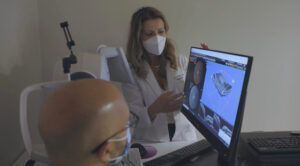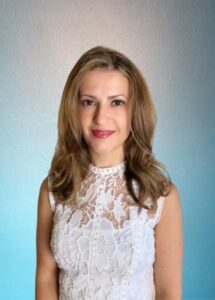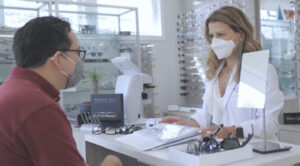August 15, 2023
By Nayiri Ajoian, OD
The success of myopia management has a lot to do with the fact that my patients are part of the process and own their decisions. When the family is all on board, it drives the motivation of the patient to get through the fitting process and ultimately comply with wearing/using the chosen modality.
I have been practicing optometry for nearly two decades, but it wasn’t until attending a specialty contact lens lecture a few years ago that the importance of practicing myopia management clicked for me. I worked as an associate in a practice for over 15 years. In 2021, I opened my own practice cold alongside my husband’s dental practice.
After learning how invaluable myopia management is for young patients, I had two primary thoughts: Why are we not implementing this at our practice now, and where was this treatment when I was a kid? As a -5.50D myope, I can relate to how my poor uncorrected vision has impacted my quality of life.
Go Big or Go Home
Having worked alongside a cornea specialist, I have been fitting RGPs and scleral lenses for the bulk of my career, so it was not difficult to implement myopia management treatments into my practice. I began taking as many courses as possible, including the myopia management program at the Brien Holden Vision Institute, attending myopia meetings, listening to webinars and podcasts, and joining social media groups for specialty lenses and myopia management. I became certified in fitting Paragon CRT, Euclid, and Wave contact lenses. The more I learn, the more tools I have, and the better I can help my patients.
My motto is go big or go home. I felt comfortable enough to dive headfirst into myopia management. Right off the bat, I developed a protocol to present to patients, specifically their parents, which included all the available options, including orthokeratology, MiSight 1 Day, and low-dose atropine drops. I do not like to feel limited in my scope of practice, and I feel it is in the best interest of patients to present all their options and allow them the opportunity to have a say in their treatment plan and be a part of the medical decision-making process. For the most part, my patient demographic is very well informed, and they already know what they are looking for when they come to see me. Patients and parents who are hearing about myopia management for the first time need more time to think about it.
That being said, the success of myopia management has a lot to do with the fact that my patients are part of the process and own their decisions. When the family is all on board, it drives the motivation of the patient to get through the fitting process and ultimately comply with wearing/using the chosen modality. To present all the available options is a service we can uniquely provide, thus boosting our credibility as optometric physicians.
Tackling the Myopia Management Conversation
The Brien Holden Vision Institute has excellent resources for practitioners, including downloadable pamphlets and myopia guidelines. These resources helped me greatly to get started with my myopia management conversation with patients and their parents. During pre-testing, if the autorefractor shows any amount of myopia or very low hyperopia in a young child, my technician will give the parent a pre-printed handout on myopia, the risks, and the available treatments.
At the end of the exam, I present my findings to the patient and their parents and inform them that their child has myopia, what it is, and the importance of managing its progression. I find it helpful to talk about myopia as a disease that causes the elongation of the eye and puts the eye at risk for pathology. I tell them I am prescribing these treatments to slow the progression. It is also beneficial to show the parents, with trial lenses, how their child sees now and how their child will see if we do not treat their myopia. In my experience, going into all the treatment details is not helpful. It is best to schedule a separate consult/telehealth visit with both parents to discuss it further. This allows them time to process the information already given, read the literature, do their own research, and come back to me with more specific questions that are important to them.

Dr. Ajoian makes sure she stays on top of the latest myopia management research and clinical findings.
I usually get one of two reactions — either they are already on board and want to get started as soon as possible, or they are not ready to commit and want to wait and monitor their child’s progression. For the patients who defer treatment, I will monitor the child every three months.
An essential part of the myopia management conversation is being well educated on the latest research and clinical findings in myopia management. The more information I have, the better I can answer patients’ and parents’ questions — hopefully, get them started in treatment. To stay current, I regularly attend myopia meetings, listen to webinars and podcasts, and read articles published by Review of Optometry, Review of Myopia Management, and Review of Optometric Business. I also follow leading myopia management speakers on social media.
Perfecting the Process
One of the challenges I have encountered with practicing myopia management is executing the perfect process. Initially, I wanted to tell patients everything about myopia at their first visit and get the child on schedule for treatment immediately. I have found that most parents need time to digest, research, and process the information given. Therefore, it is best to schedule a follow-up visit to allow more time for questions and answers.
Another challenge for me was developing a myopia protocol that allows parents and patients to choose a treatment plan that is best for them — and not just because it was the least expensive option. Because of this, I have developed my myopia management fees to be the same global fee for one year that covers all exam fees and materials — whether it is contact lenses or glasses.
In the future, myopia management will be the standard of care. I hope that every practitioner makes it a priority — just like how treating glaucoma has become the norm in our field. Especially with the expected increase in the number of children who will become myopic in this digital world, it is our duty to provide children with the highest quality of care.
 |
Dr. Ajoian graduated from the New England College of Optometry in 2005. In 2021, she opened her practice, EyeSmile Dentistry and Optometry, alongside her husband’s dental practice, with the goal of providing the highest quality of care to her patients. She developed a passion for specialty contact lenses during her clinical rotations, first at the VA Medical Center in Portland, OR, The Braverman Eye Center in Hallandale, FL, and then at the University of Maryland Department of Ophthalmology in Baltimore, MD. Dr. Ajoian specializes in myopia management, specialty contact lenses, and dry eye treatments. |














